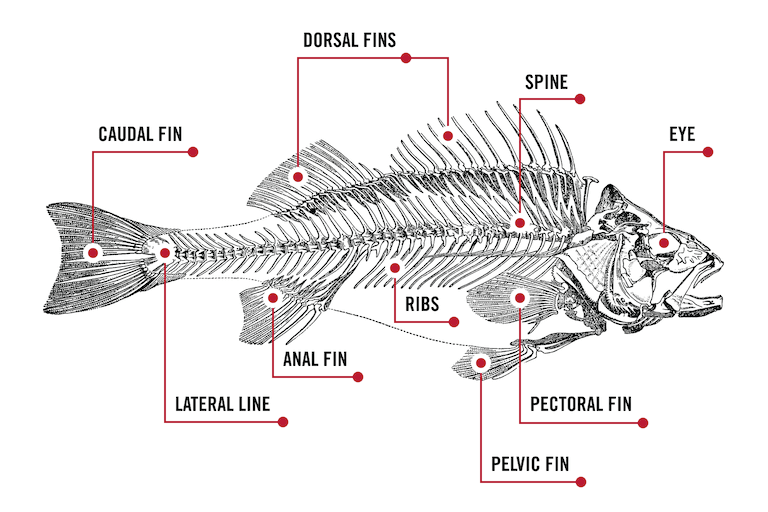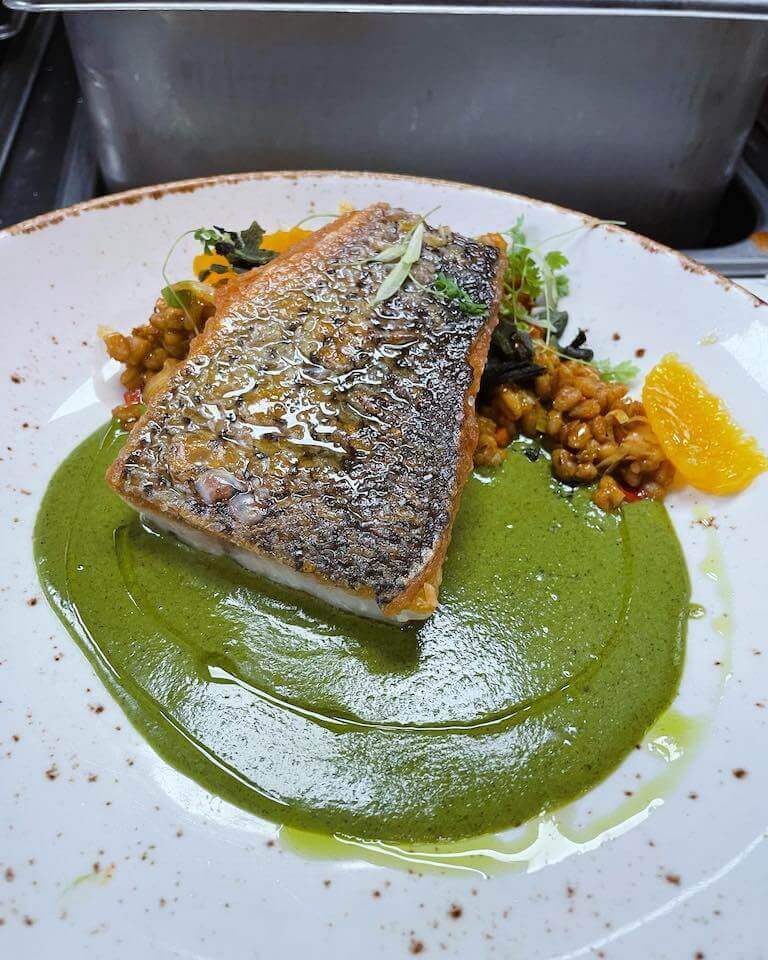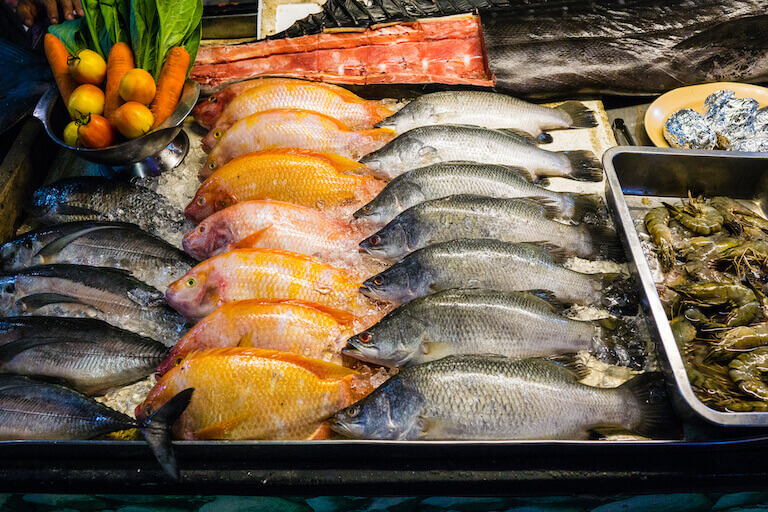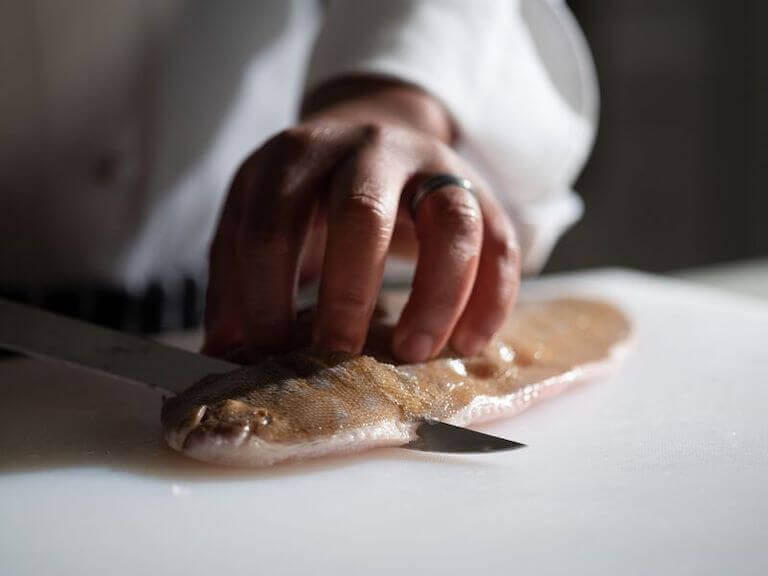Listen to This Article:
Do you want to recreate restaurant-quality fish at home but aren’t sure how to fillet a fish? Are you tired of paying a premium for pre-cut fish from the store? This beginner’s guide to fish filleting can help you ditch the pre-cuts and unlock fresh flavor.
We’re breaking down the process into simple steps, sharing common mistakes, and answering your burning questions. If you’re ready to conquer your first whole salmon and enjoy restaurant-style, pan-seared deliciousness, then let’s get filleting.
Prep Like a Pro: Gather the Essential Tools Before You Start
Before diving into the step-by-step instructions to fillet a fish, it’s important to gather the tools and equipment you may need. Having everything ready before beginning can streamline the filleting process and help you feel more confident. This is the essence of mise en place, an approach to organization that can prepare you to succeed.
Tools and Equipment to Fillet a Fish
- Fillet Knife (or substitute with a Boning Knife)
- Cutting Board
- Gloves (optional)
- Kitchen Shears
- Fish Bone Pliers
How to Fillet a Fish: Step-by-Step Guide for Beginners
This section will guide you through the techniques for filleting both round and flatfish, ensuring you maximize your catch and minimize waste.

There are several points on the fish that you’ll want to familiarize yourself with before you begin.
How to Fillet Flat Fish
Common flat fish include flounder, halibut, and sole. If you choose, you can remove the skin from a flatfish prior to filleting by making cuts along the tail, head, and each edge of the fish and then peeling back the skin, beginning at the tail. Using cloth to hold both the fish and the skin can help you maintain a better grip on the fish as you pull.
1. Find reference points on the fish: fins, spine, and ribs.
2. Make an incision behind the pectoral and pelvic fins along the edge of the fish head.
3. You can choose to cut one fillet across the entire side or cut along the center bone to create two fillets.
-
- If you want to cut one fillet, begin by cutting along one edge of the fish, working your knife toward the center. Then, you‘ll carefully cut along the center bone before continuing to work to the opposite side.
- If you want to cut two fillets from each side, after cutting along the head, cut along the center bone and then work toward the outer edge of the fish, running your knife along the tops of the bone.
4. Angle your knife as needed to stay on top of the center bone as you cut.
5. Trim any fatty tissues.
6. Feel the meat to check for bones. If you find any, remove them with your fish pliers.
How to Fillet Round Fish
Typical round fish include salmon, cod, snapper, and tilapia. As with flat fish, you can use the cloth techniques to peel back the skin of your fillets.
- Find reference points on the fish: fins, spine, and ribs.
- Make an incision behind the head, pectoral, and pelvic fins.
- Make an incision along the back along the dorsal fins and continue cutting until you reach the backbone and can feel the knife running along the vertebrae.
- Angle your knife to stay above the ribcage as you cut.
- Run the knife over the top of the ribs as you see them, and continue to run the knife the length of the backbone once you are past the ribs. (Tip: You can flip the loose fillet back down on top of the fish as you continue to run your knife toward the tail to help as you cut.)
- The fillet will now only be connected along the tail section.
- Flip the fillet over the tail and lay it on the cutting board.
- If you want to remove the skin, continue to run your knife, moving it back and forth between the fillet and the skin to remove the meat from the skin.
- If you want to keep the skin on, simply cut the edge to separate the fillet.
- Trim any fatty tissues along the edge.
- Feel the meat to check for bones. If you find any, remove them with your fish pliers.

Striped Bass with Arugula crema and spiced barley, by Boulder Culinary Arts Graduate, Sean D.
Common mistakes to avoid
Filleting fish, especially for the first time, can feel trickier than it really is. Practicing will help you improve your skills, but in the meantime, here are a few key beginner mistakes to be aware of when filleting.
- Using a dull knife
- Not knowing the type of fish you’re filleting and the anatomy
- Cutting too deep by not following the bone structure
- Bruising the fish and reducing the quality of meat from mishandling
- Not washing hands and tools thoroughly before, during, and after filleting
Choosing the Perfect Fish for Flawless Fillets
While filleting techniques play a pivotal role in the success of your cuts, it all starts with choosing the right fish. Here are some considerations to keep in mind as you choose a fish to fillet.
Freshness
Freshness is paramount, but it can be hard to know a fresh fish from last week’s catch if you don’t know what to look for.
- Visual Cues: The fish should look like you just pulled it out of the water. Look for vibrant coloration, free of discoloration or dullness.
- Eye Test: Examine the eyes of the fish. They should be clear, not cloudy or sunken.
- Fingertip Test: The flesh should give slightly and spring back firmly when gently pressed. Mushy texture or slow recovery is a sign the fish is no longer fresh.
- Nose Test: The fish should smell mild and fresh. Avoid fish with strong “fishy” odors.

The best filleting experience begins with choosing fresh fish.
Size and Species
There are two types of fish: round fish and flatfish. Round fish will produce two fillets, while flatfish provide the option to cut four fillets.
Flatfish are generally easier to fillet for beginners due to their flat bodies and clearer bone placement. However, larger flatfish, like halibut, require more effort due to their thicker flesh and skin.
Popular Fish for Filleting
Round Fish
- Salmon
- Cod
- Trout
- Snapper
- Tilapia
- Mahi-mahi
- Haddock
- Pollack
- Bass
- Mackerel
Flatfish
- Flounder
- Sole
- Halibut
- Turbot

Sea bass with smoked duchess potatoes and mixed greens by Online Culinary Arts Graduate Joseph K.
Sustainability
As the demand for seafood increases, sustainable fishing practices have become crucial to ensure that coming generations will have fish to eat. These practices help protect and maintain healthy fish populations while minimizing the environmental impact.
Educate yourself on sustainable fishing practices. The Environmental Defense Fund provides details to help you source eco-friendly fish.
Frequently Asked Questions About Filleting
Have questions about filleting? Dive into our Q&A below to find answers to commonly asked questions.
How is Tranching Different from Filleting?
Tranching is a cutting technique where you slice a fillet into thinner slices. These slices maximize the surface area and flavor of fish. Think tender swordfish carpaccio or melt-in-your-mouth salmon crudo.
Methods:
- Angled: Create thin, diagonal slices by holding your knife at a 45-degree angle
- Length: Create long, uniform strips by slicing directly down the length of the fillet
Whichever option you choose, let the fish rest for five minutes before slicing. The rest time ensures optimal texture and cleaner cuts.
What Kind of Knife Should I Use to Fillet a Fish?
The classic knife choice to fillet a fish is a filleting knife. It’s specifically designed for the purpose of filleting with a thin, flexible blade that is typically 6-9 inches long.
If you don’t have a filleting knife available, you can substitute a boning knife. This knife has a stiffer blade and is best used for larger fish with thicker cuts.

Choosing the right knife makes it easier to fillet fish.
Do I Need to Scale the Fish Before Filleting?
Scaling can make filleting easier for fish with large, removable scales, like salmon. But for fish with small, embedded scales like cod, it’s unnecessary and can be tricky.
If you follow the round fish filleting instructions above, you’ll remove the skin and scales in the process. However, if you want to scale a fish prior to filleting, you can use a fish scaler or a spoon. Use light pressure when scaling to avoid bruising the fish.
How Do I Avoid Cutting Into the Bones?
Understanding the anatomy of the fish is the best way to avoid cutting into bones as you fillet. Remember to move slowly so you can follow the bone structure and avoid cutting too deep.
What Do I Do With the Leftover Scraps and Bones?
There are many ways to use leftover fish bones and scraps. You can use them as compost or find recipes that call for fish bone or scraps, such as fish skin chips or soup stock.
Beyond the Basics: Learning Advanced Techniques
Gone are the days of relying on pre-cut fish from the store. When you master filleting, you unlock a world of fresh, delicious seafood possibilities in your own kitchen.
Dive into a symphony of flavors with poaching, steaming, and en papillote techniques. Explore culinary traditions from around the world with Thai fish curries, Japanese tempura, or Italian cioppino. Elevate the presentation of your dish by learning to plate like a professional chef to wow your guests, all starting with the perfect fillet.
But the journey doesn’t have to end there. Ignite your passion for a culinary career with Escoffier’s Culinary Arts Programs. You can hone the skills you need to craft mouthwatering dishes while carving your path in the culinary world. Reach out today to explore the best program option for you.
TO LEARN MORE ABOUT COOKING WITH FISH, TRY THESE ARTICLES NEXT:
- How to Make Fish Tacos
- The Perfect Crispy Skin Finish For Your Fish Dishes
- Cooking for a Crowd: Techniques for Scaling Recipes
*Information may not reflect every student’s experience. Results and outcomes may be based on several factors, such as geographical region or previous experience.



